Investigating Employee Motivation's Impact on Four Seasons Hotel
VerifiedAdded on 2021/02/19
|22
|4091
|21
Report
AI Summary
This research report investigates the impact of employee motivation on organizational output, specifically focusing on the Four Seasons Hotel. The report begins with an introduction outlining the research background, aim, objectives, research questions, rationale, and significance of the study. A comprehensive literature review explores various themes related to employee motivation, current motivational practices, the positive impacts of motivation on profitability, challenges arising from a lack of motivation, and recommendations for improvement. The methodology section details the research methods, design, philosophy, approach, sampling techniques, and ethical considerations. The findings and data analysis chapter covers data collection and analysis, followed by data interpretation. The conclusion and recommendation chapter summarizes the key findings and suggests actionable strategies for enhancing employee motivation. The research employs a qualitative approach, utilizing non-probabilistic sampling to gather insights from 20 managers at Four Seasons Hotel. The report emphasizes the importance of employee motivation for organizational success, highlighting its effects on productivity, profitability, and overall performance. The study also identifies the challenges faced by organizations due to a lack of employee motivation and proposes effective measures to address these issues. The report is a valuable resource for understanding employee motivation and its impact on organizational outcomes.
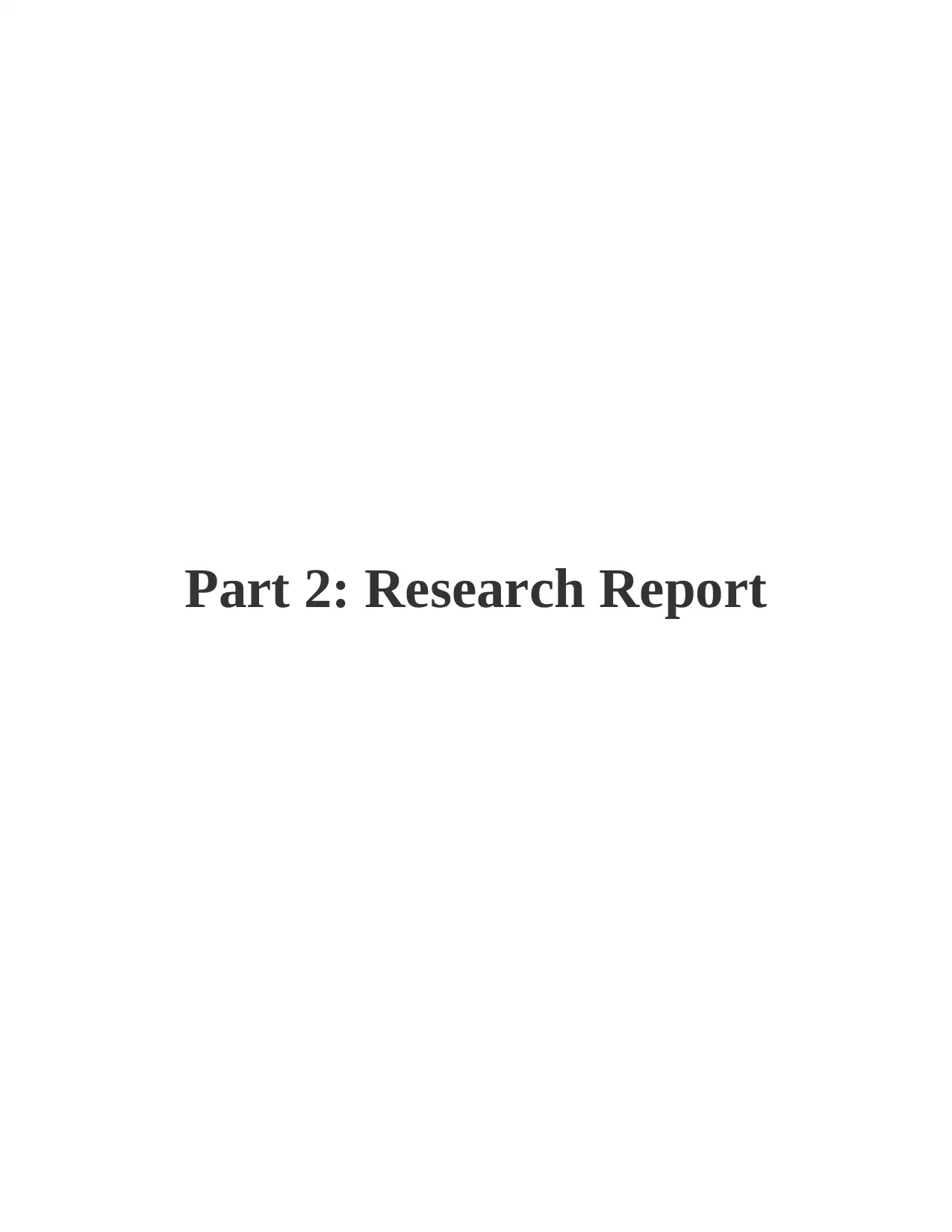
Part 2: Research Report
Paraphrase This Document
Need a fresh take? Get an instant paraphrase of this document with our AI Paraphraser
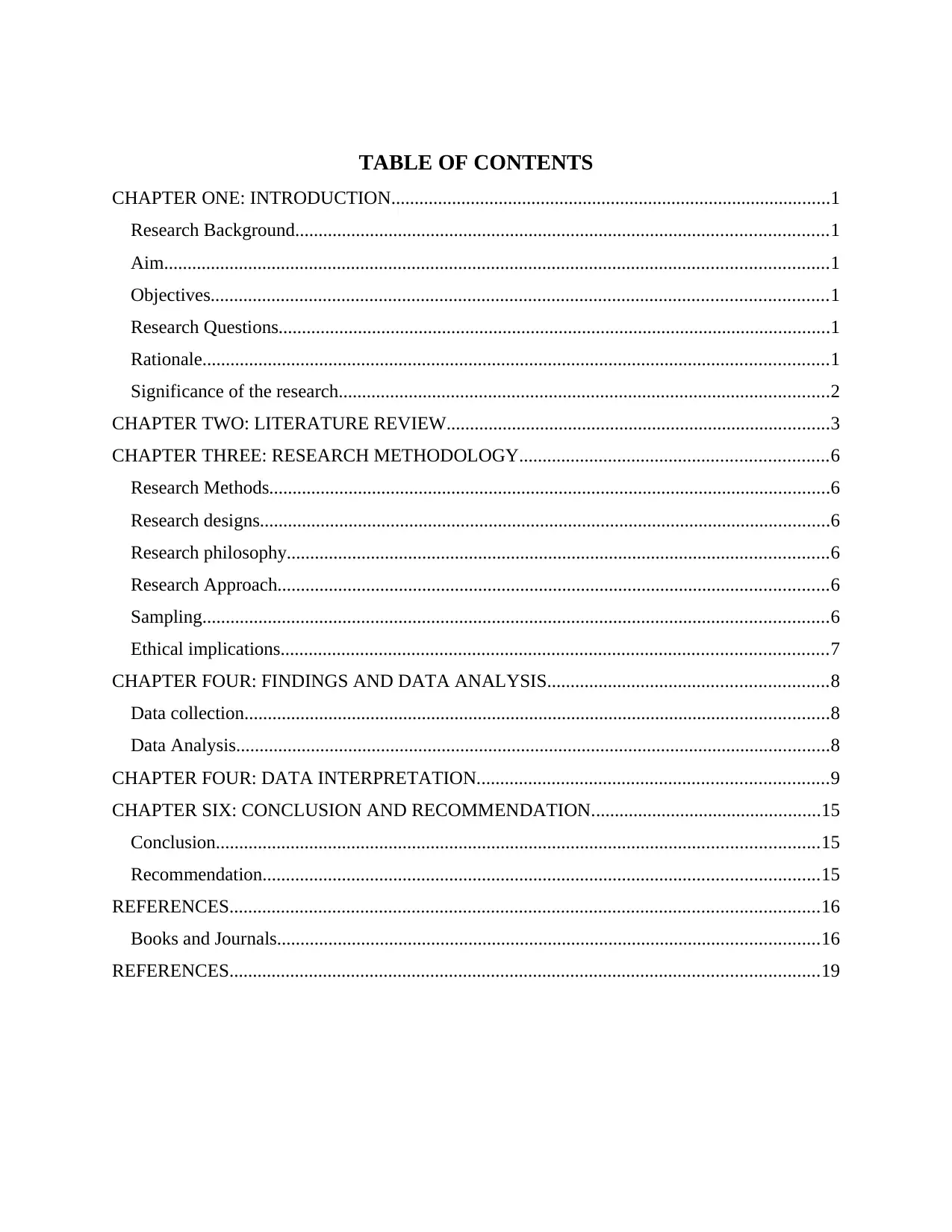
TABLE OF CONTENTS
CHAPTER ONE: INTRODUCTION..............................................................................................1
Research Background..................................................................................................................1
Aim..............................................................................................................................................1
Objectives....................................................................................................................................1
Research Questions......................................................................................................................1
Rationale......................................................................................................................................1
Significance of the research.........................................................................................................2
CHAPTER TWO: LITERATURE REVIEW..................................................................................3
CHAPTER THREE: RESEARCH METHODOLOGY..................................................................6
Research Methods........................................................................................................................6
Research designs..........................................................................................................................6
Research philosophy....................................................................................................................6
Research Approach......................................................................................................................6
Sampling......................................................................................................................................6
Ethical implications.....................................................................................................................7
CHAPTER FOUR: FINDINGS AND DATA ANALYSIS............................................................8
Data collection.............................................................................................................................8
Data Analysis...............................................................................................................................8
CHAPTER FOUR: DATA INTERPRETATION...........................................................................9
CHAPTER SIX: CONCLUSION AND RECOMMENDATION.................................................15
Conclusion.................................................................................................................................15
Recommendation.......................................................................................................................15
REFERENCES..............................................................................................................................16
Books and Journals....................................................................................................................16
REFERENCES..............................................................................................................................19
CHAPTER ONE: INTRODUCTION..............................................................................................1
Research Background..................................................................................................................1
Aim..............................................................................................................................................1
Objectives....................................................................................................................................1
Research Questions......................................................................................................................1
Rationale......................................................................................................................................1
Significance of the research.........................................................................................................2
CHAPTER TWO: LITERATURE REVIEW..................................................................................3
CHAPTER THREE: RESEARCH METHODOLOGY..................................................................6
Research Methods........................................................................................................................6
Research designs..........................................................................................................................6
Research philosophy....................................................................................................................6
Research Approach......................................................................................................................6
Sampling......................................................................................................................................6
Ethical implications.....................................................................................................................7
CHAPTER FOUR: FINDINGS AND DATA ANALYSIS............................................................8
Data collection.............................................................................................................................8
Data Analysis...............................................................................................................................8
CHAPTER FOUR: DATA INTERPRETATION...........................................................................9
CHAPTER SIX: CONCLUSION AND RECOMMENDATION.................................................15
Conclusion.................................................................................................................................15
Recommendation.......................................................................................................................15
REFERENCES..............................................................................................................................16
Books and Journals....................................................................................................................16
REFERENCES..............................................................................................................................19
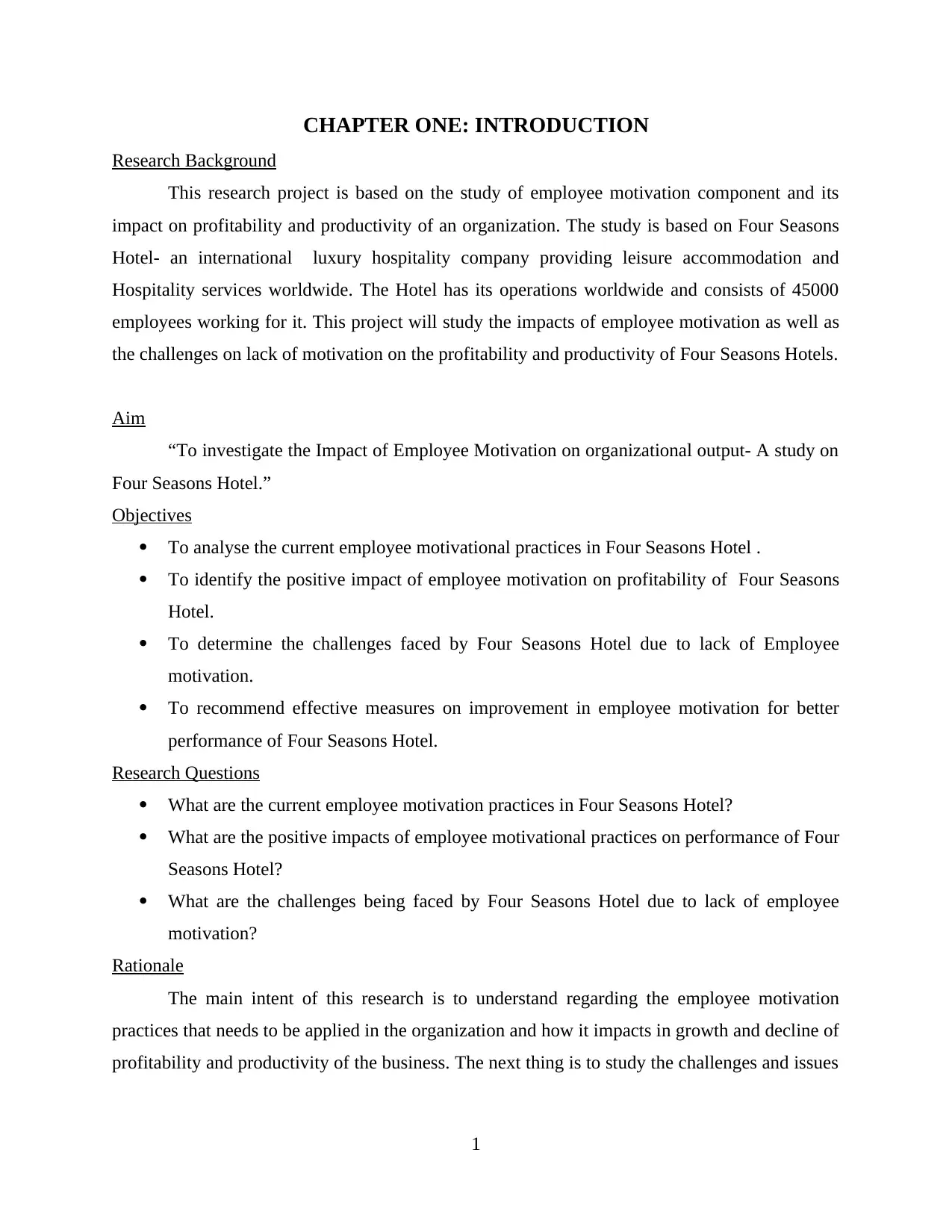
CHAPTER ONE: INTRODUCTION
Research Background
This research project is based on the study of employee motivation component and its
impact on profitability and productivity of an organization. The study is based on Four Seasons
Hotel- an international luxury hospitality company providing leisure accommodation and
Hospitality services worldwide. The Hotel has its operations worldwide and consists of 45000
employees working for it. This project will study the impacts of employee motivation as well as
the challenges on lack of motivation on the profitability and productivity of Four Seasons Hotels.
Aim
“To investigate the Impact of Employee Motivation on organizational output- A study on
Four Seasons Hotel.”
Objectives
To analyse the current employee motivational practices in Four Seasons Hotel .
To identify the positive impact of employee motivation on profitability of Four Seasons
Hotel.
To determine the challenges faced by Four Seasons Hotel due to lack of Employee
motivation.
To recommend effective measures on improvement in employee motivation for better
performance of Four Seasons Hotel.
Research Questions
What are the current employee motivation practices in Four Seasons Hotel?
What are the positive impacts of employee motivational practices on performance of Four
Seasons Hotel?
What are the challenges being faced by Four Seasons Hotel due to lack of employee
motivation?
Rationale
The main intent of this research is to understand regarding the employee motivation
practices that needs to be applied in the organization and how it impacts in growth and decline of
profitability and productivity of the business. The next thing is to study the challenges and issues
1
Research Background
This research project is based on the study of employee motivation component and its
impact on profitability and productivity of an organization. The study is based on Four Seasons
Hotel- an international luxury hospitality company providing leisure accommodation and
Hospitality services worldwide. The Hotel has its operations worldwide and consists of 45000
employees working for it. This project will study the impacts of employee motivation as well as
the challenges on lack of motivation on the profitability and productivity of Four Seasons Hotels.
Aim
“To investigate the Impact of Employee Motivation on organizational output- A study on
Four Seasons Hotel.”
Objectives
To analyse the current employee motivational practices in Four Seasons Hotel .
To identify the positive impact of employee motivation on profitability of Four Seasons
Hotel.
To determine the challenges faced by Four Seasons Hotel due to lack of Employee
motivation.
To recommend effective measures on improvement in employee motivation for better
performance of Four Seasons Hotel.
Research Questions
What are the current employee motivation practices in Four Seasons Hotel?
What are the positive impacts of employee motivational practices on performance of Four
Seasons Hotel?
What are the challenges being faced by Four Seasons Hotel due to lack of employee
motivation?
Rationale
The main intent of this research is to understand regarding the employee motivation
practices that needs to be applied in the organization and how it impacts in growth and decline of
profitability and productivity of the business. The next thing is to study the challenges and issues
1
⊘ This is a preview!⊘
Do you want full access?
Subscribe today to unlock all pages.

Trusted by 1+ million students worldwide
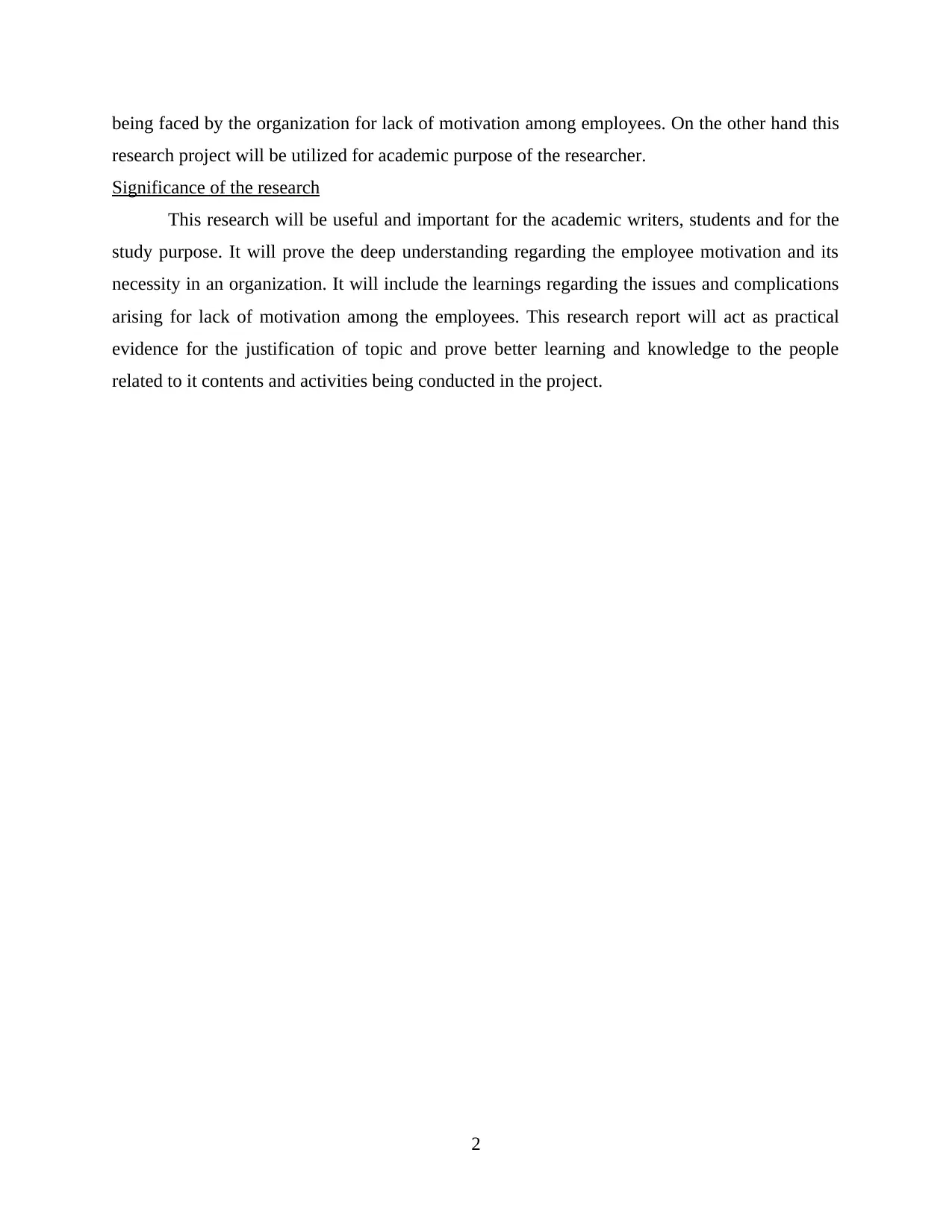
being faced by the organization for lack of motivation among employees. On the other hand this
research project will be utilized for academic purpose of the researcher.
Significance of the research
This research will be useful and important for the academic writers, students and for the
study purpose. It will prove the deep understanding regarding the employee motivation and its
necessity in an organization. It will include the learnings regarding the issues and complications
arising for lack of motivation among the employees. This research report will act as practical
evidence for the justification of topic and prove better learning and knowledge to the people
related to it contents and activities being conducted in the project.
2
research project will be utilized for academic purpose of the researcher.
Significance of the research
This research will be useful and important for the academic writers, students and for the
study purpose. It will prove the deep understanding regarding the employee motivation and its
necessity in an organization. It will include the learnings regarding the issues and complications
arising for lack of motivation among the employees. This research report will act as practical
evidence for the justification of topic and prove better learning and knowledge to the people
related to it contents and activities being conducted in the project.
2
Paraphrase This Document
Need a fresh take? Get an instant paraphrase of this document with our AI Paraphraser
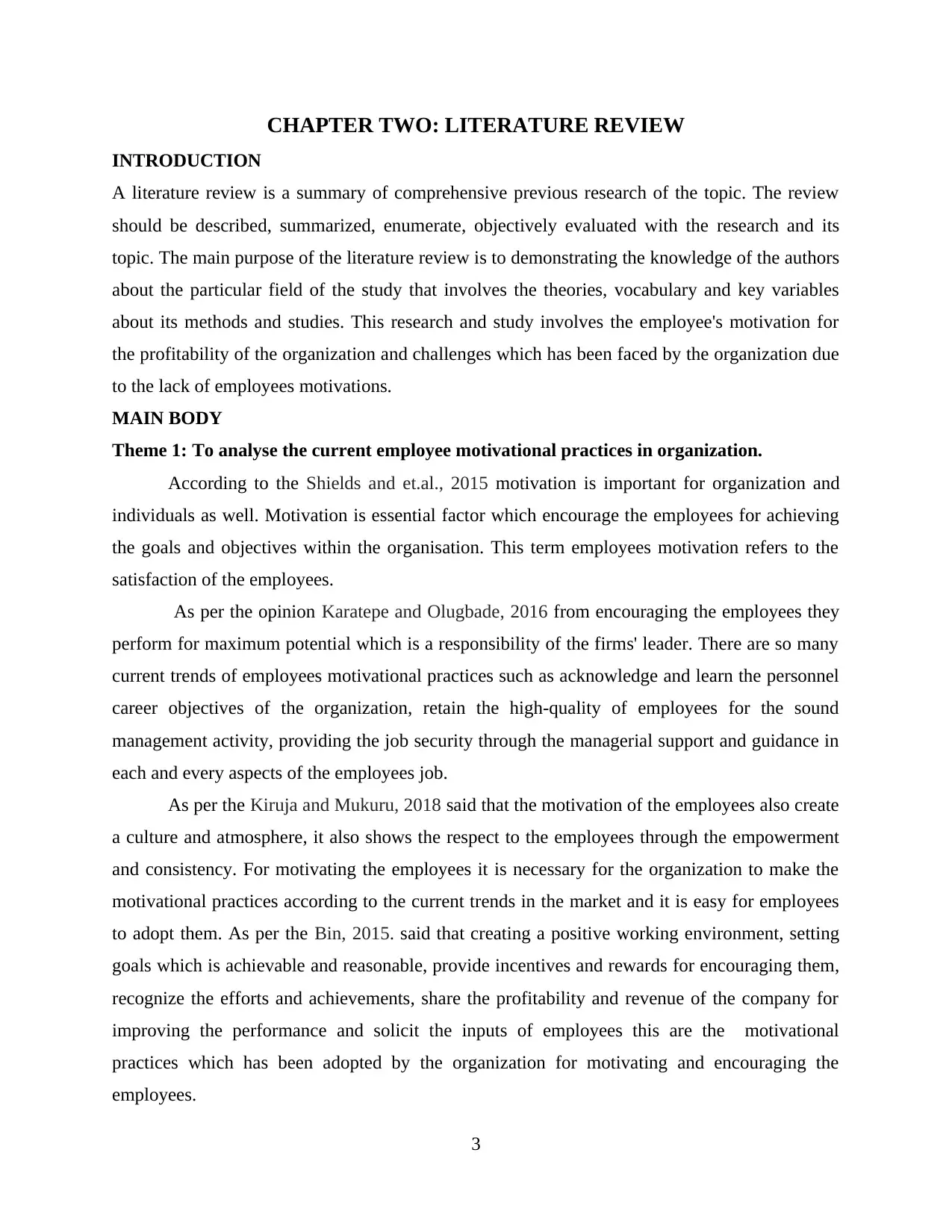
CHAPTER TWO: LITERATURE REVIEW
INTRODUCTION
A literature review is a summary of comprehensive previous research of the topic. The review
should be described, summarized, enumerate, objectively evaluated with the research and its
topic. The main purpose of the literature review is to demonstrating the knowledge of the authors
about the particular field of the study that involves the theories, vocabulary and key variables
about its methods and studies. This research and study involves the employee's motivation for
the profitability of the organization and challenges which has been faced by the organization due
to the lack of employees motivations.
MAIN BODY
Theme 1: To analyse the current employee motivational practices in organization.
According to the Shields and et.al., 2015 motivation is important for organization and
individuals as well. Motivation is essential factor which encourage the employees for achieving
the goals and objectives within the organisation. This term employees motivation refers to the
satisfaction of the employees.
As per the opinion Karatepe and Olugbade, 2016 from encouraging the employees they
perform for maximum potential which is a responsibility of the firms' leader. There are so many
current trends of employees motivational practices such as acknowledge and learn the personnel
career objectives of the organization, retain the high-quality of employees for the sound
management activity, providing the job security through the managerial support and guidance in
each and every aspects of the employees job.
As per the Kiruja and Mukuru, 2018 said that the motivation of the employees also create
a culture and atmosphere, it also shows the respect to the employees through the empowerment
and consistency. For motivating the employees it is necessary for the organization to make the
motivational practices according to the current trends in the market and it is easy for employees
to adopt them. As per the Bin, 2015. said that creating a positive working environment, setting
goals which is achievable and reasonable, provide incentives and rewards for encouraging them,
recognize the efforts and achievements, share the profitability and revenue of the company for
improving the performance and solicit the inputs of employees this are the motivational
practices which has been adopted by the organization for motivating and encouraging the
employees.
3
INTRODUCTION
A literature review is a summary of comprehensive previous research of the topic. The review
should be described, summarized, enumerate, objectively evaluated with the research and its
topic. The main purpose of the literature review is to demonstrating the knowledge of the authors
about the particular field of the study that involves the theories, vocabulary and key variables
about its methods and studies. This research and study involves the employee's motivation for
the profitability of the organization and challenges which has been faced by the organization due
to the lack of employees motivations.
MAIN BODY
Theme 1: To analyse the current employee motivational practices in organization.
According to the Shields and et.al., 2015 motivation is important for organization and
individuals as well. Motivation is essential factor which encourage the employees for achieving
the goals and objectives within the organisation. This term employees motivation refers to the
satisfaction of the employees.
As per the opinion Karatepe and Olugbade, 2016 from encouraging the employees they
perform for maximum potential which is a responsibility of the firms' leader. There are so many
current trends of employees motivational practices such as acknowledge and learn the personnel
career objectives of the organization, retain the high-quality of employees for the sound
management activity, providing the job security through the managerial support and guidance in
each and every aspects of the employees job.
As per the Kiruja and Mukuru, 2018 said that the motivation of the employees also create
a culture and atmosphere, it also shows the respect to the employees through the empowerment
and consistency. For motivating the employees it is necessary for the organization to make the
motivational practices according to the current trends in the market and it is easy for employees
to adopt them. As per the Bin, 2015. said that creating a positive working environment, setting
goals which is achievable and reasonable, provide incentives and rewards for encouraging them,
recognize the efforts and achievements, share the profitability and revenue of the company for
improving the performance and solicit the inputs of employees this are the motivational
practices which has been adopted by the organization for motivating and encouraging the
employees.
3
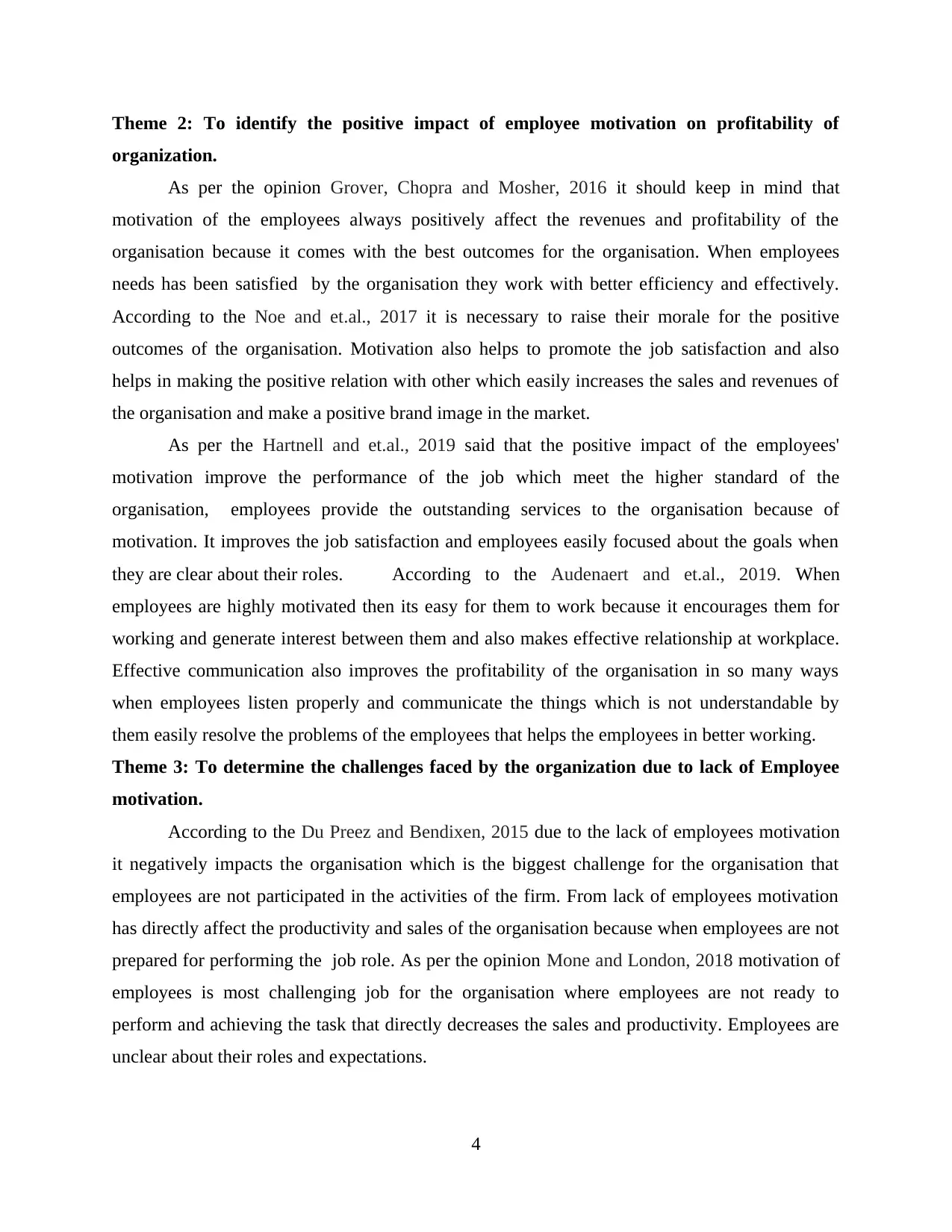
Theme 2: To identify the positive impact of employee motivation on profitability of
organization.
As per the opinion Grover, Chopra and Mosher, 2016 it should keep in mind that
motivation of the employees always positively affect the revenues and profitability of the
organisation because it comes with the best outcomes for the organisation. When employees
needs has been satisfied by the organisation they work with better efficiency and effectively.
According to the Noe and et.al., 2017 it is necessary to raise their morale for the positive
outcomes of the organisation. Motivation also helps to promote the job satisfaction and also
helps in making the positive relation with other which easily increases the sales and revenues of
the organisation and make a positive brand image in the market.
As per the Hartnell and et.al., 2019 said that the positive impact of the employees'
motivation improve the performance of the job which meet the higher standard of the
organisation, employees provide the outstanding services to the organisation because of
motivation. It improves the job satisfaction and employees easily focused about the goals when
they are clear about their roles. According to the Audenaert and et.al., 2019. When
employees are highly motivated then its easy for them to work because it encourages them for
working and generate interest between them and also makes effective relationship at workplace.
Effective communication also improves the profitability of the organisation in so many ways
when employees listen properly and communicate the things which is not understandable by
them easily resolve the problems of the employees that helps the employees in better working.
Theme 3: To determine the challenges faced by the organization due to lack of Employee
motivation.
According to the Du Preez and Bendixen, 2015 due to the lack of employees motivation
it negatively impacts the organisation which is the biggest challenge for the organisation that
employees are not participated in the activities of the firm. From lack of employees motivation
has directly affect the productivity and sales of the organisation because when employees are not
prepared for performing the job role. As per the opinion Mone and London, 2018 motivation of
employees is most challenging job for the organisation where employees are not ready to
perform and achieving the task that directly decreases the sales and productivity. Employees are
unclear about their roles and expectations.
4
organization.
As per the opinion Grover, Chopra and Mosher, 2016 it should keep in mind that
motivation of the employees always positively affect the revenues and profitability of the
organisation because it comes with the best outcomes for the organisation. When employees
needs has been satisfied by the organisation they work with better efficiency and effectively.
According to the Noe and et.al., 2017 it is necessary to raise their morale for the positive
outcomes of the organisation. Motivation also helps to promote the job satisfaction and also
helps in making the positive relation with other which easily increases the sales and revenues of
the organisation and make a positive brand image in the market.
As per the Hartnell and et.al., 2019 said that the positive impact of the employees'
motivation improve the performance of the job which meet the higher standard of the
organisation, employees provide the outstanding services to the organisation because of
motivation. It improves the job satisfaction and employees easily focused about the goals when
they are clear about their roles. According to the Audenaert and et.al., 2019. When
employees are highly motivated then its easy for them to work because it encourages them for
working and generate interest between them and also makes effective relationship at workplace.
Effective communication also improves the profitability of the organisation in so many ways
when employees listen properly and communicate the things which is not understandable by
them easily resolve the problems of the employees that helps the employees in better working.
Theme 3: To determine the challenges faced by the organization due to lack of Employee
motivation.
According to the Du Preez and Bendixen, 2015 due to the lack of employees motivation
it negatively impacts the organisation which is the biggest challenge for the organisation that
employees are not participated in the activities of the firm. From lack of employees motivation
has directly affect the productivity and sales of the organisation because when employees are not
prepared for performing the job role. As per the opinion Mone and London, 2018 motivation of
employees is most challenging job for the organisation where employees are not ready to
perform and achieving the task that directly decreases the sales and productivity. Employees are
unclear about their roles and expectations.
4
⊘ This is a preview!⊘
Do you want full access?
Subscribe today to unlock all pages.

Trusted by 1+ million students worldwide
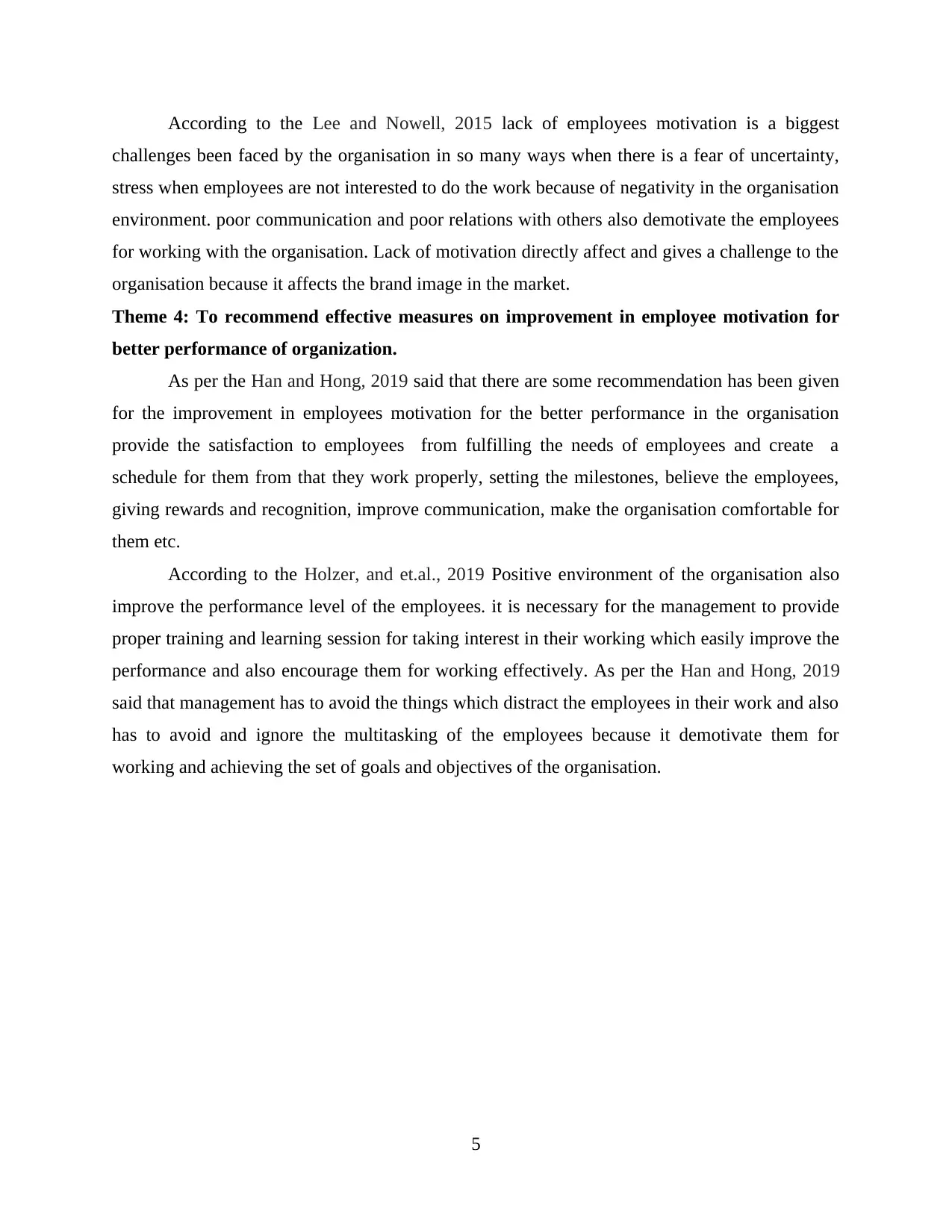
According to the Lee and Nowell, 2015 lack of employees motivation is a biggest
challenges been faced by the organisation in so many ways when there is a fear of uncertainty,
stress when employees are not interested to do the work because of negativity in the organisation
environment. poor communication and poor relations with others also demotivate the employees
for working with the organisation. Lack of motivation directly affect and gives a challenge to the
organisation because it affects the brand image in the market.
Theme 4: To recommend effective measures on improvement in employee motivation for
better performance of organization.
As per the Han and Hong, 2019 said that there are some recommendation has been given
for the improvement in employees motivation for the better performance in the organisation
provide the satisfaction to employees from fulfilling the needs of employees and create a
schedule for them from that they work properly, setting the milestones, believe the employees,
giving rewards and recognition, improve communication, make the organisation comfortable for
them etc.
According to the Holzer, and et.al., 2019 Positive environment of the organisation also
improve the performance level of the employees. it is necessary for the management to provide
proper training and learning session for taking interest in their working which easily improve the
performance and also encourage them for working effectively. As per the Han and Hong, 2019
said that management has to avoid the things which distract the employees in their work and also
has to avoid and ignore the multitasking of the employees because it demotivate them for
working and achieving the set of goals and objectives of the organisation.
5
challenges been faced by the organisation in so many ways when there is a fear of uncertainty,
stress when employees are not interested to do the work because of negativity in the organisation
environment. poor communication and poor relations with others also demotivate the employees
for working with the organisation. Lack of motivation directly affect and gives a challenge to the
organisation because it affects the brand image in the market.
Theme 4: To recommend effective measures on improvement in employee motivation for
better performance of organization.
As per the Han and Hong, 2019 said that there are some recommendation has been given
for the improvement in employees motivation for the better performance in the organisation
provide the satisfaction to employees from fulfilling the needs of employees and create a
schedule for them from that they work properly, setting the milestones, believe the employees,
giving rewards and recognition, improve communication, make the organisation comfortable for
them etc.
According to the Holzer, and et.al., 2019 Positive environment of the organisation also
improve the performance level of the employees. it is necessary for the management to provide
proper training and learning session for taking interest in their working which easily improve the
performance and also encourage them for working effectively. As per the Han and Hong, 2019
said that management has to avoid the things which distract the employees in their work and also
has to avoid and ignore the multitasking of the employees because it demotivate them for
working and achieving the set of goals and objectives of the organisation.
5
Paraphrase This Document
Need a fresh take? Get an instant paraphrase of this document with our AI Paraphraser
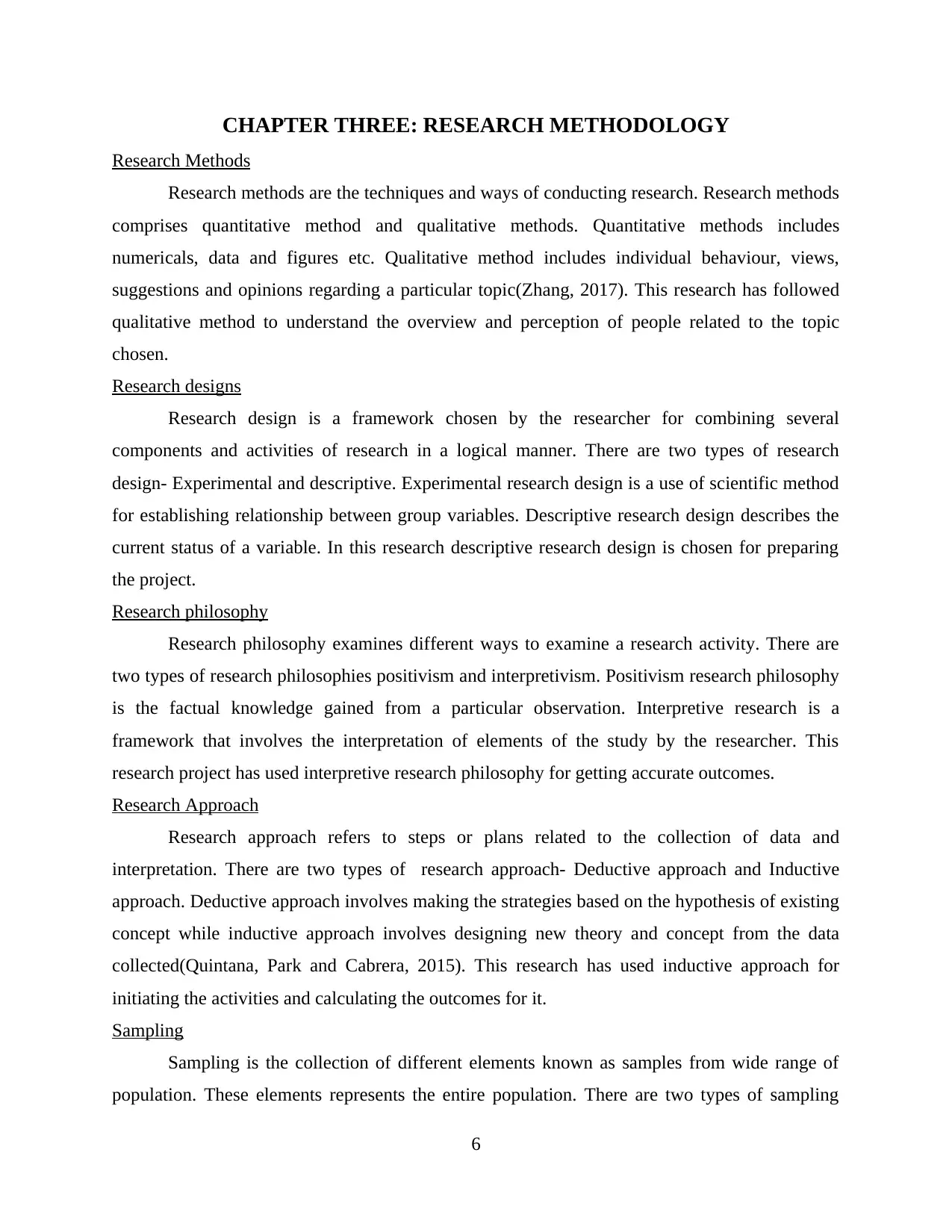
CHAPTER THREE: RESEARCH METHODOLOGY
Research Methods
Research methods are the techniques and ways of conducting research. Research methods
comprises quantitative method and qualitative methods. Quantitative methods includes
numericals, data and figures etc. Qualitative method includes individual behaviour, views,
suggestions and opinions regarding a particular topic(Zhang, 2017). This research has followed
qualitative method to understand the overview and perception of people related to the topic
chosen.
Research designs
Research design is a framework chosen by the researcher for combining several
components and activities of research in a logical manner. There are two types of research
design- Experimental and descriptive. Experimental research design is a use of scientific method
for establishing relationship between group variables. Descriptive research design describes the
current status of a variable. In this research descriptive research design is chosen for preparing
the project.
Research philosophy
Research philosophy examines different ways to examine a research activity. There are
two types of research philosophies positivism and interpretivism. Positivism research philosophy
is the factual knowledge gained from a particular observation. Interpretive research is a
framework that involves the interpretation of elements of the study by the researcher. This
research project has used interpretive research philosophy for getting accurate outcomes.
Research Approach
Research approach refers to steps or plans related to the collection of data and
interpretation. There are two types of research approach- Deductive approach and Inductive
approach. Deductive approach involves making the strategies based on the hypothesis of existing
concept while inductive approach involves designing new theory and concept from the data
collected(Quintana, Park and Cabrera, 2015). This research has used inductive approach for
initiating the activities and calculating the outcomes for it.
Sampling
Sampling is the collection of different elements known as samples from wide range of
population. These elements represents the entire population. There are two types of sampling
6
Research Methods
Research methods are the techniques and ways of conducting research. Research methods
comprises quantitative method and qualitative methods. Quantitative methods includes
numericals, data and figures etc. Qualitative method includes individual behaviour, views,
suggestions and opinions regarding a particular topic(Zhang, 2017). This research has followed
qualitative method to understand the overview and perception of people related to the topic
chosen.
Research designs
Research design is a framework chosen by the researcher for combining several
components and activities of research in a logical manner. There are two types of research
design- Experimental and descriptive. Experimental research design is a use of scientific method
for establishing relationship between group variables. Descriptive research design describes the
current status of a variable. In this research descriptive research design is chosen for preparing
the project.
Research philosophy
Research philosophy examines different ways to examine a research activity. There are
two types of research philosophies positivism and interpretivism. Positivism research philosophy
is the factual knowledge gained from a particular observation. Interpretive research is a
framework that involves the interpretation of elements of the study by the researcher. This
research project has used interpretive research philosophy for getting accurate outcomes.
Research Approach
Research approach refers to steps or plans related to the collection of data and
interpretation. There are two types of research approach- Deductive approach and Inductive
approach. Deductive approach involves making the strategies based on the hypothesis of existing
concept while inductive approach involves designing new theory and concept from the data
collected(Quintana, Park and Cabrera, 2015). This research has used inductive approach for
initiating the activities and calculating the outcomes for it.
Sampling
Sampling is the collection of different elements known as samples from wide range of
population. These elements represents the entire population. There are two types of sampling
6
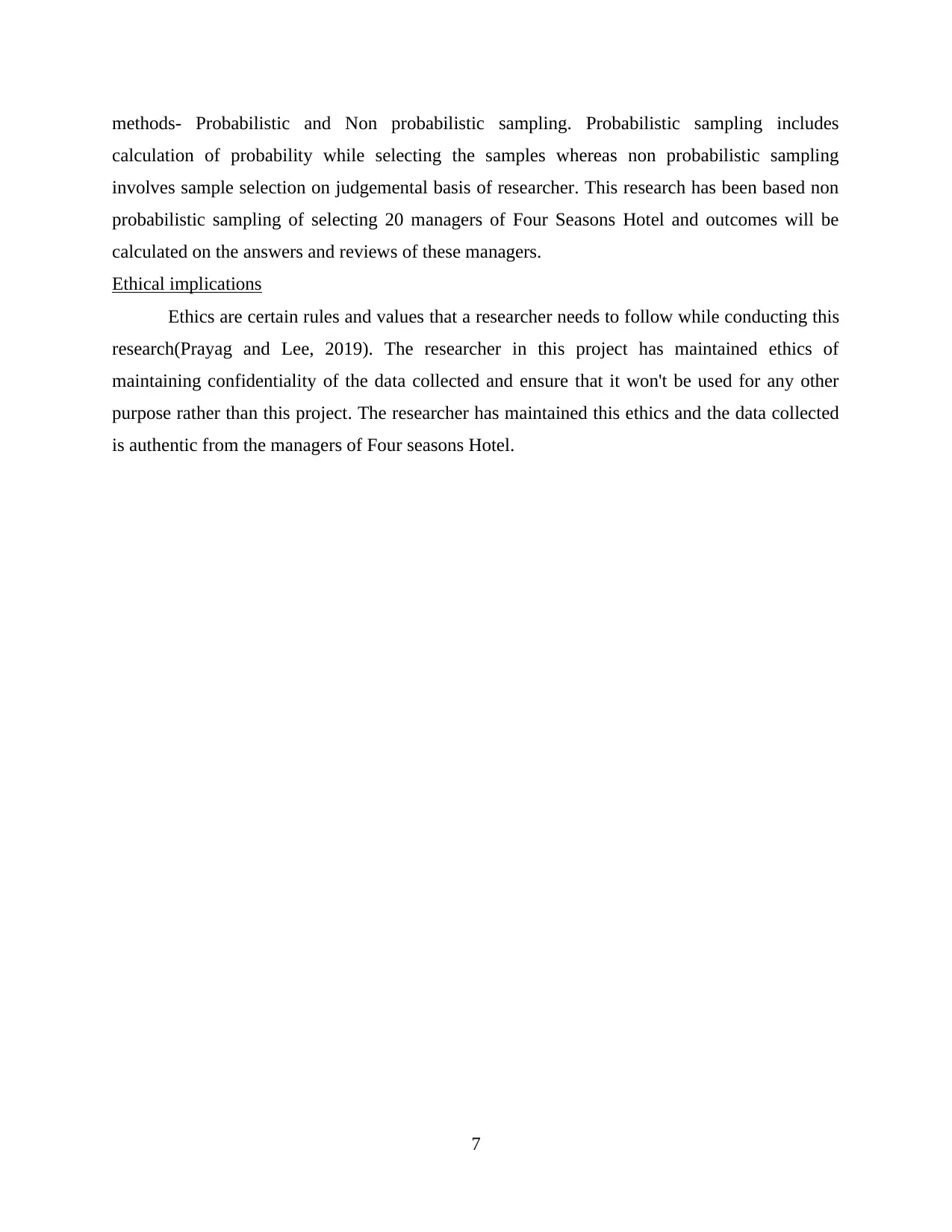
methods- Probabilistic and Non probabilistic sampling. Probabilistic sampling includes
calculation of probability while selecting the samples whereas non probabilistic sampling
involves sample selection on judgemental basis of researcher. This research has been based non
probabilistic sampling of selecting 20 managers of Four Seasons Hotel and outcomes will be
calculated on the answers and reviews of these managers.
Ethical implications
Ethics are certain rules and values that a researcher needs to follow while conducting this
research(Prayag and Lee, 2019). The researcher in this project has maintained ethics of
maintaining confidentiality of the data collected and ensure that it won't be used for any other
purpose rather than this project. The researcher has maintained this ethics and the data collected
is authentic from the managers of Four seasons Hotel.
7
calculation of probability while selecting the samples whereas non probabilistic sampling
involves sample selection on judgemental basis of researcher. This research has been based non
probabilistic sampling of selecting 20 managers of Four Seasons Hotel and outcomes will be
calculated on the answers and reviews of these managers.
Ethical implications
Ethics are certain rules and values that a researcher needs to follow while conducting this
research(Prayag and Lee, 2019). The researcher in this project has maintained ethics of
maintaining confidentiality of the data collected and ensure that it won't be used for any other
purpose rather than this project. The researcher has maintained this ethics and the data collected
is authentic from the managers of Four seasons Hotel.
7
⊘ This is a preview!⊘
Do you want full access?
Subscribe today to unlock all pages.

Trusted by 1+ million students worldwide
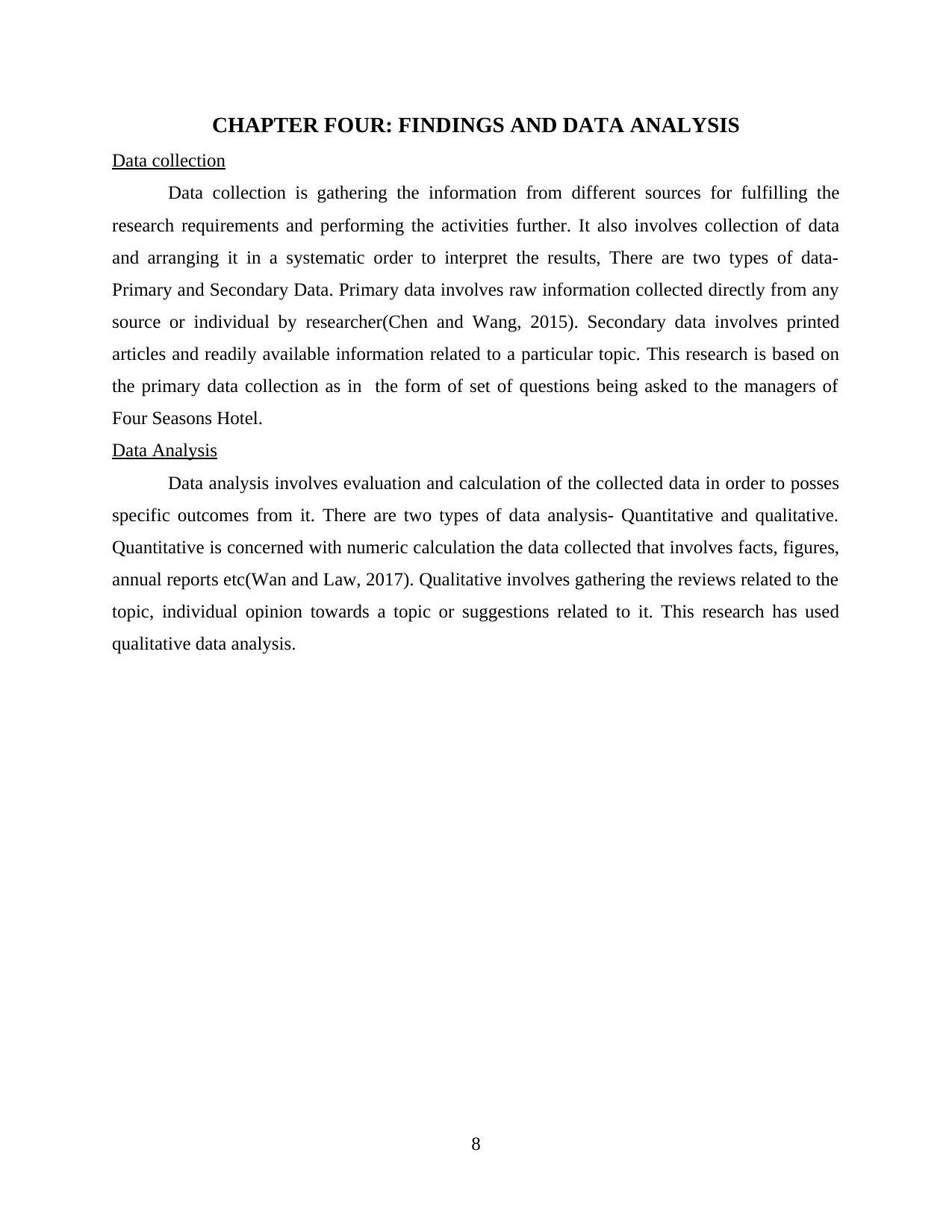
CHAPTER FOUR: FINDINGS AND DATA ANALYSIS
Data collection
Data collection is gathering the information from different sources for fulfilling the
research requirements and performing the activities further. It also involves collection of data
and arranging it in a systematic order to interpret the results, There are two types of data-
Primary and Secondary Data. Primary data involves raw information collected directly from any
source or individual by researcher(Chen and Wang, 2015). Secondary data involves printed
articles and readily available information related to a particular topic. This research is based on
the primary data collection as in the form of set of questions being asked to the managers of
Four Seasons Hotel.
Data Analysis
Data analysis involves evaluation and calculation of the collected data in order to posses
specific outcomes from it. There are two types of data analysis- Quantitative and qualitative.
Quantitative is concerned with numeric calculation the data collected that involves facts, figures,
annual reports etc(Wan and Law, 2017). Qualitative involves gathering the reviews related to the
topic, individual opinion towards a topic or suggestions related to it. This research has used
qualitative data analysis.
8
Data collection
Data collection is gathering the information from different sources for fulfilling the
research requirements and performing the activities further. It also involves collection of data
and arranging it in a systematic order to interpret the results, There are two types of data-
Primary and Secondary Data. Primary data involves raw information collected directly from any
source or individual by researcher(Chen and Wang, 2015). Secondary data involves printed
articles and readily available information related to a particular topic. This research is based on
the primary data collection as in the form of set of questions being asked to the managers of
Four Seasons Hotel.
Data Analysis
Data analysis involves evaluation and calculation of the collected data in order to posses
specific outcomes from it. There are two types of data analysis- Quantitative and qualitative.
Quantitative is concerned with numeric calculation the data collected that involves facts, figures,
annual reports etc(Wan and Law, 2017). Qualitative involves gathering the reviews related to the
topic, individual opinion towards a topic or suggestions related to it. This research has used
qualitative data analysis.
8
Paraphrase This Document
Need a fresh take? Get an instant paraphrase of this document with our AI Paraphraser
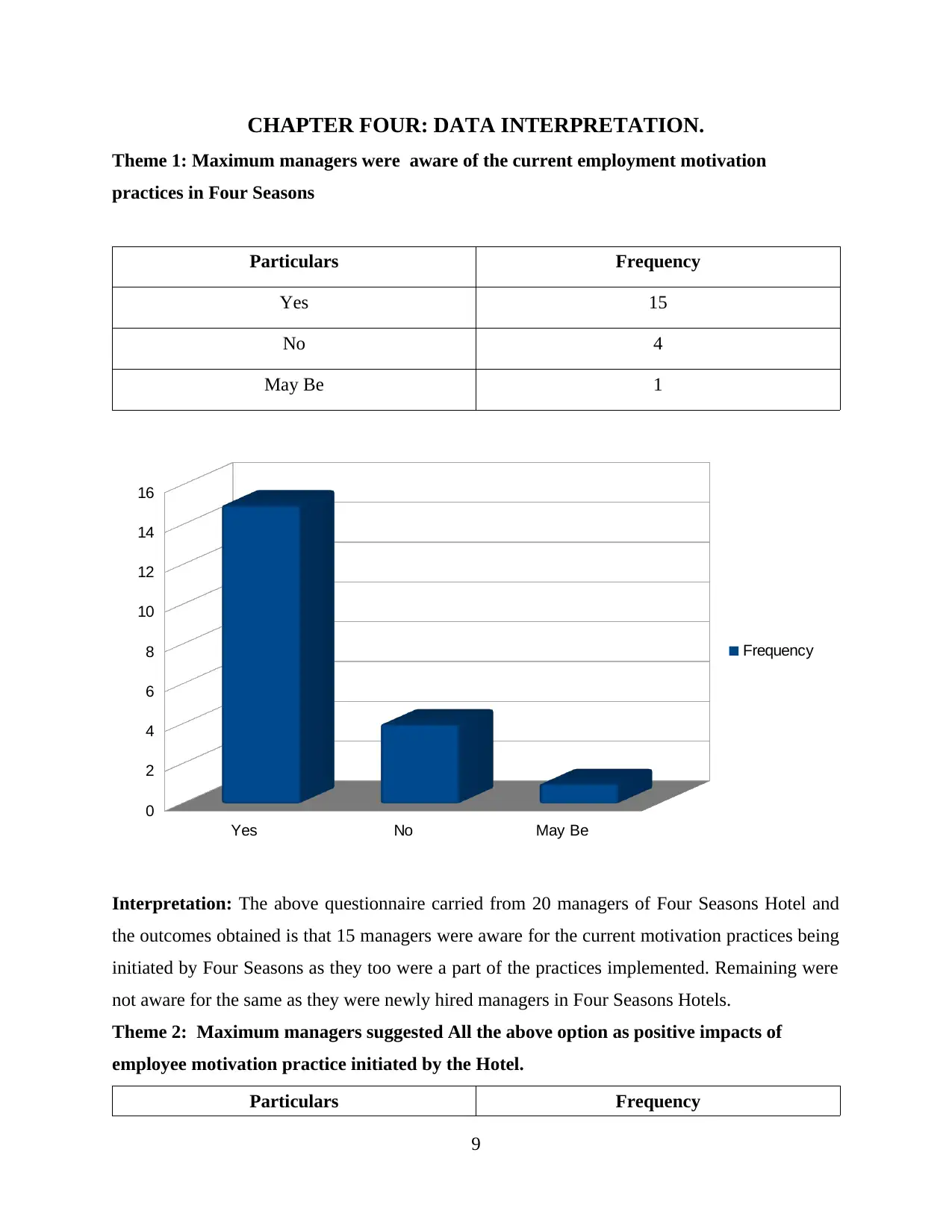
CHAPTER FOUR: DATA INTERPRETATION.
Theme 1: Maximum managers were aware of the current employment motivation
practices in Four Seasons
Particulars Frequency
Yes 15
No 4
May Be 1
Interpretation: The above questionnaire carried from 20 managers of Four Seasons Hotel and
the outcomes obtained is that 15 managers were aware for the current motivation practices being
initiated by Four Seasons as they too were a part of the practices implemented. Remaining were
not aware for the same as they were newly hired managers in Four Seasons Hotels.
Theme 2: Maximum managers suggested All the above option as positive impacts of
employee motivation practice initiated by the Hotel.
Particulars Frequency
9
Yes No May Be
0
2
4
6
8
10
12
14
16
Frequency
Theme 1: Maximum managers were aware of the current employment motivation
practices in Four Seasons
Particulars Frequency
Yes 15
No 4
May Be 1
Interpretation: The above questionnaire carried from 20 managers of Four Seasons Hotel and
the outcomes obtained is that 15 managers were aware for the current motivation practices being
initiated by Four Seasons as they too were a part of the practices implemented. Remaining were
not aware for the same as they were newly hired managers in Four Seasons Hotels.
Theme 2: Maximum managers suggested All the above option as positive impacts of
employee motivation practice initiated by the Hotel.
Particulars Frequency
9
Yes No May Be
0
2
4
6
8
10
12
14
16
Frequency
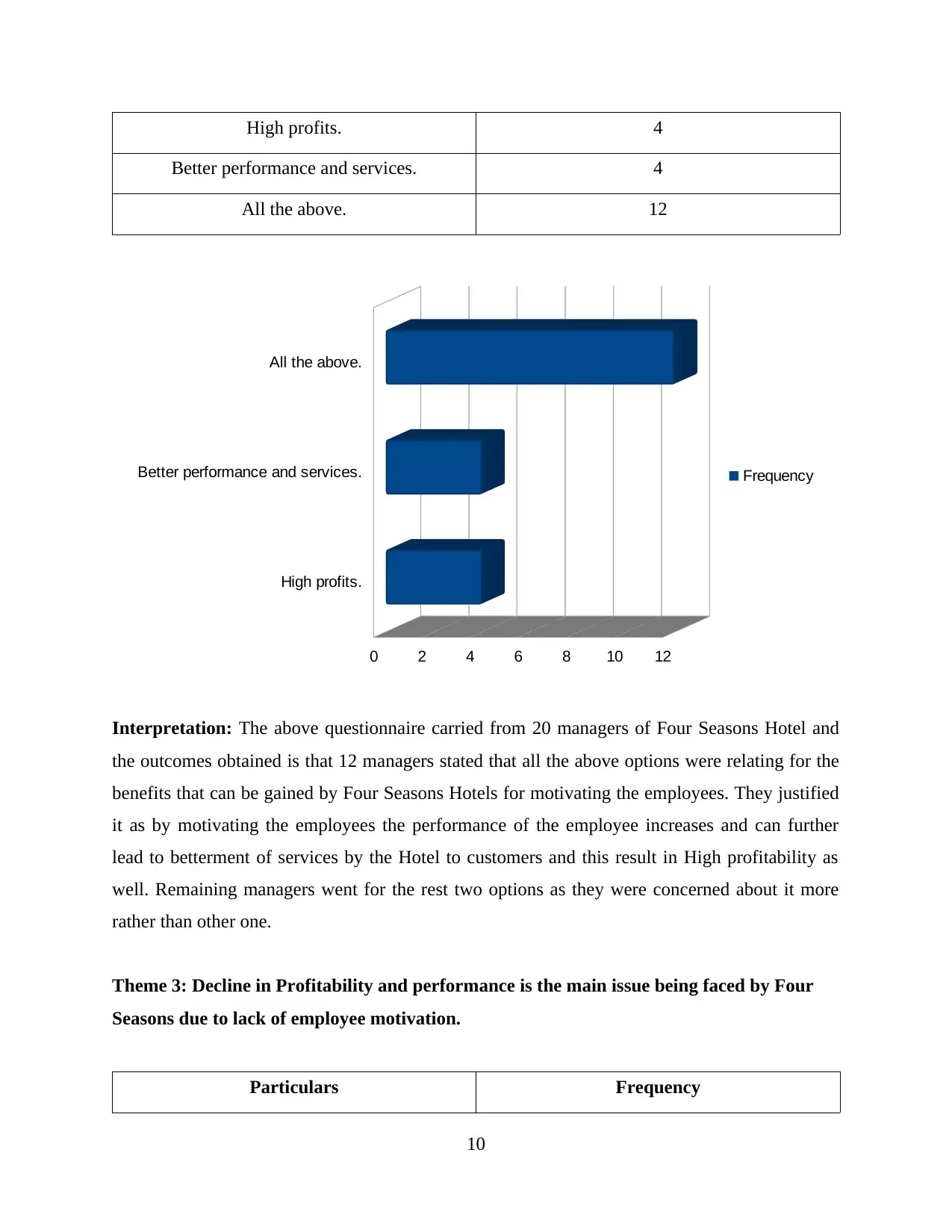
High profits. 4
Better performance and services. 4
All the above. 12
Interpretation: The above questionnaire carried from 20 managers of Four Seasons Hotel and
the outcomes obtained is that 12 managers stated that all the above options were relating for the
benefits that can be gained by Four Seasons Hotels for motivating the employees. They justified
it as by motivating the employees the performance of the employee increases and can further
lead to betterment of services by the Hotel to customers and this result in High profitability as
well. Remaining managers went for the rest two options as they were concerned about it more
rather than other one.
Theme 3: Decline in Profitability and performance is the main issue being faced by Four
Seasons due to lack of employee motivation.
Particulars Frequency
10
High profits.
Better performance and services.
All the above.
0 2 4 6 8 10 12
Frequency
Better performance and services. 4
All the above. 12
Interpretation: The above questionnaire carried from 20 managers of Four Seasons Hotel and
the outcomes obtained is that 12 managers stated that all the above options were relating for the
benefits that can be gained by Four Seasons Hotels for motivating the employees. They justified
it as by motivating the employees the performance of the employee increases and can further
lead to betterment of services by the Hotel to customers and this result in High profitability as
well. Remaining managers went for the rest two options as they were concerned about it more
rather than other one.
Theme 3: Decline in Profitability and performance is the main issue being faced by Four
Seasons due to lack of employee motivation.
Particulars Frequency
10
High profits.
Better performance and services.
All the above.
0 2 4 6 8 10 12
Frequency
⊘ This is a preview!⊘
Do you want full access?
Subscribe today to unlock all pages.

Trusted by 1+ million students worldwide
1 out of 22
Related Documents
Your All-in-One AI-Powered Toolkit for Academic Success.
+13062052269
info@desklib.com
Available 24*7 on WhatsApp / Email
![[object Object]](/_next/static/media/star-bottom.7253800d.svg)
Unlock your academic potential
Copyright © 2020–2025 A2Z Services. All Rights Reserved. Developed and managed by ZUCOL.



